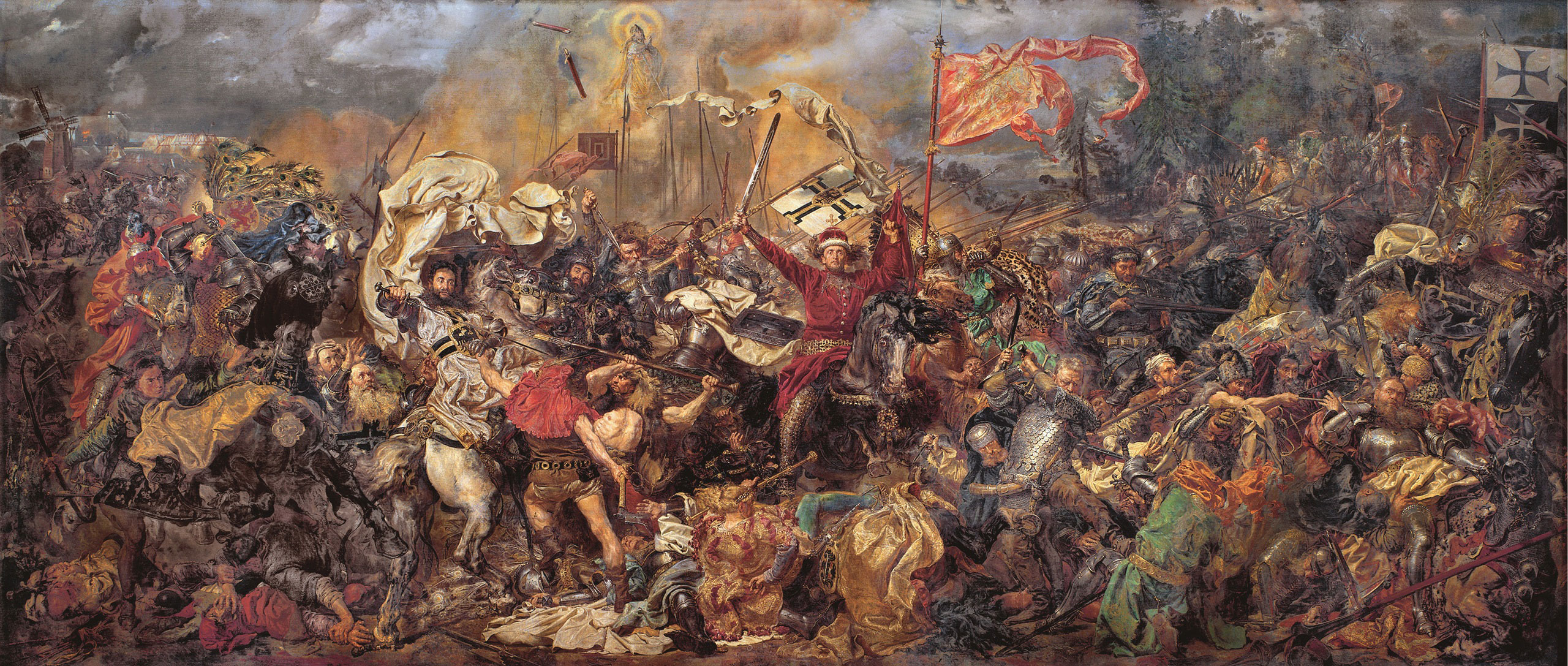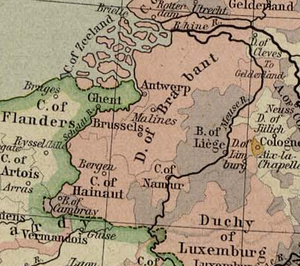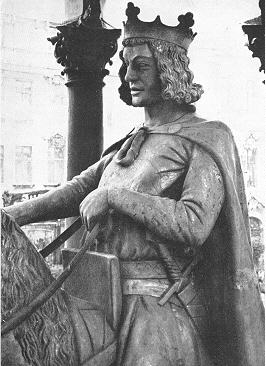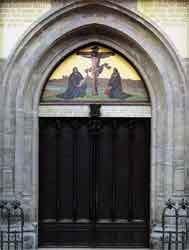Our story
This chapter
Who rules the roost?
Duking it out
Up in arms
Money talks
Bibliography
Temper
Footnotes
|
|
Last revision: December 28, 2007 The Holy Roman Empire (962–1806), occasionally referred to in modern times as the First Thousand-Year Reich in contrast to Adolf Hitler's Third Reich, was a union of central-European medieval states of which the Emperor (the Kaiser) was elected by a small number of the very uppercrust of German nobility, the Electors. The candidate would be expected to offer concessions of land or money to the electors in order to secure their vote. This practice led to an uneasy coexistence of the Empire as a whole with the struggle of the dukes and prince-bishops of the local territories to grab more power for themselves. Although the Kaiser was the sole sovereign, i.e. only answerable to God, he could not intervene in the affairs of the heads of the numerous states as long as they ruled according to law. In this, the Holy Roman Empire differed from France and England and it is thus that the heads of duchies and bishoprics, etc. were perceived by their inhabitants as their real rulers. 3 Contemporaries did not quite know how to characterize this empire. In his famous 1667 description, De statu imperii Germanici, published under the alias Severinus de Monzambano, Samuel Pufendorf wrote: "Nihil ergo aliud restat, quam ut dicamus Germaniam esse irregulare aliquod corpus et monstro simile ..." ("We are therefore left with calling Germany a body that conforms to no rule and resembles a monster"). In his Essai sur l'histoire generale et sur les moeurs et l'esprit des nations (1756), French philosopher Voltaire described the Holy Roman Empire as an "agglomeration" which was "neither holy, nor Roman, nor an empire." And in Faust I, in a scene written in 1775, the German author Goethe has one of the drinkers in Auerbach's Cellar in Leipzig ask "Our Holy Roman Empire, lads, what still holds it together?" 4 Not only was there an ongoing power struggle between the Emperor on the one hand, and the dukes and prince-bishops on the other, but also between the dukes, etc. themselves. Many a battle was (ref.) fought, among them a very bloody one near Baesweiler, 20 km north of Aachen. Three thousand 3000 knights and other equestrians were killed on August 20, 1371. 5 This is how it came about. At the time, large groups of mercenaries roamed the lands of western Europe, pillaging wherever they came. After French mercenaries robbed a number of Brabançon merchants on the territory of William, Duke of Jülich, Wenzel, then Duke of Brabant, demanded reparations. This William refused and, moreover, he did not punish the mercenaries. William even went so far as to protect them and hiring some of them. Duke Wenzel subsequently allied himself with men of Köln in a move against William of Jülich. Many a knight placed himself under the banner of Brabant, among them Reynart Huyn van Amstenrode and his cousin, Johann van Amstenrode de Jonge. 7 In July a number of infantry, including archers, were sent against Gottfried Von Heinsberg, Williams's brother-in-law. By mid-August, Wenceslas had gathered about 8,000 men, including numerous veterans from Brabant, Limburg, and Luxemburg. Namur and the Bishopric of Luttich also sent contingents. Having reviewed his men at Maastricht on August 20, Wenceslas led his army through the lands of Falkenburg into those of the Count of Jülich. He paused near Baesweiler north of Aachen, and began to burn the surrounding area to draw his opponent into action. Upon geting the news that the enemy was approaching, he drew up his army in two divisions, one of 6,000 men under his personal command and the command of the Count of St Paul, the other of 2,000 men under Robert of Namur. William was supported by Eduard von Geldern and William von Berg, two Counts of Nassau, the Count of Katzenellenbogen, and many others including a number of Westphalian troops. The ensuing battle opened favorably for Wenceslas, and the Brabançon seemed to be gaining the advantage. But in his triumph, Wenceslas failed to adequately guard his flank and Eduard von Geldern swung his division against it. Exploiting the ensuing confusion, William urged his flagging troops back to the press, and the Brabançons broke. With 300 knights, Wenceslas held his ground for a time, but was eventually captured while Eduard lay dead, slain as he raised his visor to drink. 8 Wenceslas was released for a massive ransom that was reluctantly paid by the cities of his dutchy. The Van Amstenrodes, too, were captured and released for ransom: 725 moutons for Reynart, 390.5 moutons for his cousin.* 10 A few paragraphs ought be devoted on the effect of a seemingly small technological advancement. It is the stirrup. The stirrup, along with horse breeding and more advanced iron and steel working, allowed for development of a powerful cavalry. Whereas the Romans of antiquity deployed their equestrians primarily as lightly-armed scouts and auxiliaries, the stirrup enabled riders to more effectively brace lances, and lean far to the side to swing weapons. 11 With the stirrup, a new form of warfare, centered on small cadres of elite and expensive, mounted fighters,* was both a product of and a contributing factor to the social order of the Middle Ages. Being a mounted warrior required great skill and much training and, therefore, had to be a full time job. A new social structure evolved with a division of society into a powerful upper class of nobles and a great mass of commoners. Warfare was a way of life in Medieval Europe--not only the nobles, but many commoner soldiers also served as professionals. Anyone who wished to maintain his safety and security had to be ready for a fight. Medieval Europe became, without much exaggeration, a population in arms. 13 The military tactics were simplistic in the extreme. Both sides lined up their masses of mounted troops, with foot soldiers in the front ranks.* It was usually the infantry who began a battle. When one or the other side's leader judged the moment appropriate, a mass charge of mounted men would be launched. Not only were the mounted men superior because of their horses, the knights were also better armed and armored than the foot soldiers. Socially, they disdained the men on foot and a basic problem was that every noble thought he was above obeying orders. Discipline was simply incompatible with a noble warrior's honor. Most knights (of whatever rank) merely wanted to get at the enemy and fight it out man to man. Such was the mentality of knights through most of the medieval period. 14  The fiercest battle fought in medieval Europe was the Battle of Grunwald. This decisive battle of the Polish-Lithuanian-Teutonic War (1409–1411) took place on July 15, 1410 between the Kingdom of Poland, the Grand Duchy of Lithuania and their allies on one side, and the Knights of the Teutonic Order on the other. (Source.) 15 A peculiar aspect of war in medieval Europe was chivalry. The feudal knight was supposed to be devout, honest, selfless, just, brave, honorable, obedient, kind, charitable, generous, and kind to women. His life was to some extent governed by complex rituals and rules by which he effectively belonged to an international brotherhood. But chivalry existed only among the upper classes of society and did not restrain a person of rank in his dealings with the lower orders. Rarely did an army treat local inhabitants with respect. An army's march through an area—be it friendly or not—was more often than not marked by looting, arson, rape, torture, murder, and all the other usual atrocities, with hunger and disease bringing up the rear. 16 It was common to make war pay for itself. One way was to exact ransom from prisoners-of-war. Because medieval nobles fought in expensive, and pretty effective, armor, they usually survived any defeat. Being of a class that transcended nationality and language, it was considered good manners, as well as good business, to take enemy nobles alive and hold them for ransom. It provided mercenary soldiers with a way to enhance their fortunes. (Ref..) 17 Bibliography
One participant in the Battle of Baesweiler was Sceyfaert van Musschenbroek, a knight who fought on the side of the Duke Wenceslas. He, too, was captured in that battle, but, according to our source, by the Duke of Gelre, Willem van Gulik. Well, by one or the other presumably. The Duke of Gelre's name was Eduard, who was killed in the battle; Gulik is Dutch for Jülich. Scaefaert, too, was released for ransom, but as a consequence lost his title. To this day (Dec. 30, 2007) Elisabeth Hendrika van Eyken still corresponds with a Greetje Jansen né Moessenbroeck, about 86 years of age, sister of her mother's mother who hails from Antwerp. * fn1 The cost of a single mounted warrior has been estimated as equivalent to that of 45 cows. The breakdown: 6 cows for a helmet, 12 for a coat of mail, 7 for sword and scabbard, 6 for the leg greaves, 2 for a lance and shield, and 12 cows for the steed. (Original source: Hans Delbrück, History of the Art of War, Vol. 1, Ch. 1). * fn2 An animation of the Battle of Crécy, fought on August 26, 1346, by the armies of King Edward III of England and King Philip VI of France is an example of how medieval battlelines were deployed. This animation depicts the first use of the longbow and may not be representative for the Battle of Baesweiler. * fn3 |
--
| top of page |
|
Page maintenance:
Page format: February 13, 2015
Story edit:
To be checked for timeliness:
¶ none
Reminders:
¶ none
Link check: not done
XHTML verify: not done
Backups: month. 25, 2011



